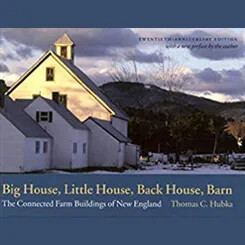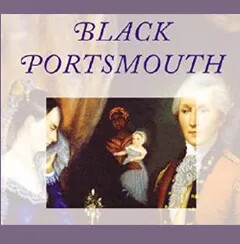How did Portsmouth emerge as the colony's capital, and what role did slavery play in colonial New Hampshire?
Within just a few decades of the English settling in New Hampshire, Portsmouth emerged as the largest and most significant of the colony’s towns. By 1720, it was dominated by the many merchants who conducted business there. Portsmouth’s merchant class was part of the triangle trade, a complicated economic system that involved the exchange of goods and people between Europe, Africa, the West Indies (i.e., the Caribbean), and America. The shipping routes didn’t really form a triangle on the map, but the term is generally used today to refer to trading practices in the Atlantic world in the 17th and 18th centuries among the three continents. A major pillar of this system of exchange was the trans-Atlantic slave trade. Portsmouth’s merchants owned ships that took New Hampshire’s chief commodities—fish, fur, and lumber—to Europe and the West Indies. From Europe, merchants purchased a range of products not readily available in America, like manufactured goods, spices, and tea (the latter two imported to Europe from India and China). In Africa, they loaded their ships with Black people who were enslaved; many of them were traded for goods in the West Indies. In the West Indies, merchants bought sugar and molasses, both of which were in high demand in New England. It is said that at one point in the 18th century, Portsmouth had more than 200 ships sailing in and out of its busy wharves and docks. These business ventures made the fortunes of many families in Portsmouth, allowing them to build impressive homes and create a town that offered entertainment and luxury to those who could afford it.
With all of the money in Portsmouth, it’s hardly surprising that it became the political capital of New Hampshire. Portsmouth was also New Hampshire’s largest population center throughout the colonial period, with a population of around 5,000 people by 1770. It was one of the largest urban centers in colonial America. The colony’s legislature met there until the American Revolution, holding sessions in taverns until a public building was constructed for the legislature and the courts in 1760. This building was located in Market Square, the bustling economic heart of the community. Many of the colony’s political leaders lived in Portsmouth as well, including the powerful Wentworth family and their allies. New Hampshire’s first newspaper, the New Hampshire Gazette, began publishing in 1756 in Portsmouth, another indication of Portsmouth’s prominence in the colony’s affairs.
Portsmouth was also New Hampshire’s only seaport, and in the 18th century, it became known throughout the American colonies for its deep harbor and shipbuilding industry. Ship carpentry was Portsmouth’s chief occupation for those in the skilled trades, and as the 18th century progressed, Portsmouth built larger ships, including commercial vessels for American merchants and military vessels for the British navy.
Slavery. Merchants’ connections to the slave trade brought New Hampshire’s first Black people to its shores in 1645. Slavery was legal in New Hampshire, at least in a de facto sense. The colony had never passed a law legalizing it, but neither was there a law prohibiting it during the colonial period. There were, indisputably, enslaved people in New Hampshire, and their enslavement was viewed as sanctioned by law. Slavery, in fact, existed in all American colonies at this time. After the first small group of enslaved people arrived in Portsmouth in 1645, more were brought to the colony in the years that followed, although New Hampshire’s enslaved population remained just a fraction of the colony’s population as a whole. Only a small percentage of New Hampshire’s white population ever had enslaved people in their households or on their farms.
Unlike in the American South where large slave communities formed on plantations, most enslaved people in Portsmouth lived in households with, at most, one or two others who were held in the same condition of servitude. They were employed in a wide variety of jobs, both skilled (blacksmithing, carpentry, maritime pursuits, pottery) and unskilled (laundry, cooking, household service, farming).
Educators should be under no illusions that slavery in New Hampshire was somehow more gentle or benign than it was elsewhere in America. Frequent advertisements in Portsmouth newspapers regarding sales of enslaved people show that Black residents were treated as property rather than people, and the number of notices regarding runaway slaves provides evidence that enslaved people were not laboring voluntarily. For those in bondage, slavery denied them the freedom to live as they chose, a restriction that was handed down to their children and grandchildren as well.
Portsmouth in the colonial period also had free Black people, a population that continued to grow throughout the 18th century. Although a small percentage arrived in New Hampshire already free, most free Black people had once been enslaved. They gained their freedom in a number of ways, sometimes by purchasing it from their white owners. White owners could also granted freedom to enslaved people as a “gift” or reward for faithful service. Since a person’s status was determined by the status of their mother, once a Black woman was free, all of her descendants would be as well, thus leading to the growth of this segment of the population.
Black people in Portsmouth, whether enslaved or free, managed to create their own community and culture, separate from the English settlers in Portsmouth. One tradition, popular in both Portsmouth and other American population centers, involved electing a leader to represent the Black community. On an annual “Negro Election Day,” Black people in Portsmouth organized a community festival, complete with brightly colored clothes, food, music, dancing, and celebratory gunfire. They then elected their leader for the coming year, who was dubbed the “King of the Africans.” The king had a court who helped him resolve minor conflicts and maintain peace within the community. Portsmouth’s most well-known king in the late colonial period was King Nero Brewster, who during the American Revolution organized the Freedom Petition for himself and 20 other enslaved Portsmouth men. (See Unit 5: New Hampshire and the American Revolution.)
The exact number of Black people living in New Hampshire during the colonial period—both free and enslaved—is unknown, but this population grew steadily throughout the 18th century and spread beyond Portsmouth to more than 50 New Hampshire towns by mid-century. In 1707, there were fewer than 100 Black people in New Hampshire, but that number rose to nearly 700 by the American Revolution. Yet the Black population in New Hampshire was substantially smaller than it was in other New England colonies, where it numbered in the thousands rather than the hundreds.
Slavery became increasingly unpopular in New Hampshire after the Revolutionary War, but it was not declared illegal until 1857, just a few years before the outbreak of the Civil War. The topic of slavery, both in New Hampshire and in America, is discussed in several units of the “Moose on the Loose,” particularly Unit 5 (New Hampshire and the American Revolution), Unit 9 (Reforming New Hampshire), and Unit 10 (New Hampshire and the Civil War), as the issue of slavery is an important part of our shared history.
At the same time that Black servitude was increasing in New Hampshire, white servitude was decreasing. In the 17th century, Portsmouth had been home to a fair number of indentured servants—lower-class whites who agreed to work without pay for a set number of years in exchange for their passage to America and room and board during the terms of their contract. Indentured service was never as popular in New Hampshire as it was elsewhere in America, particularly in places like New York and Pennsylvania, and in the 18th century, the practice declined and eventually disappeared from the colony.
Many people in New Hampshire grew to resent Portsmouth’s dominance of colonial affairs. The town was, in fact, very different from the rest of New Hampshire, with its involvement in international trade, its urban atmosphere, and its more diverse population. These differences with the rest of New Hampshire became more pronounced as colonial settlement expanded westward in the 18th century, an expansion that was fueled almost entirely by the need for more agricultural land. Outside of Portsmouth, almost everyone in New Hampshire depended on farming, which led to the founding of towns far from the seacoast and the way of life that had been established there.












